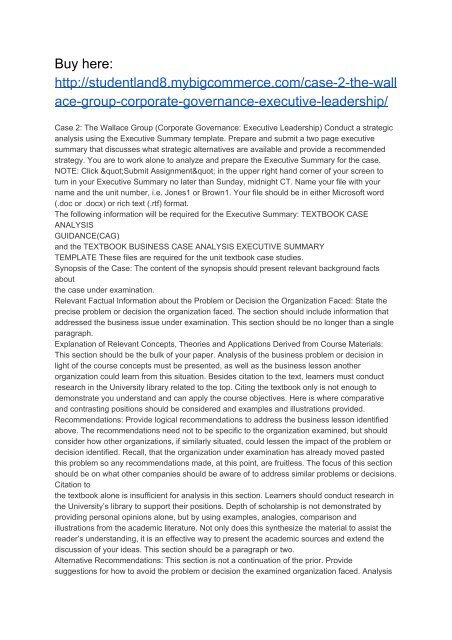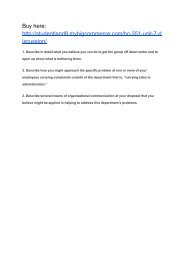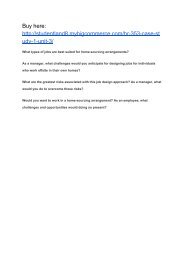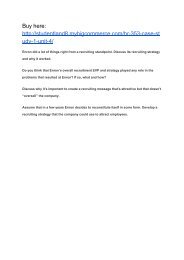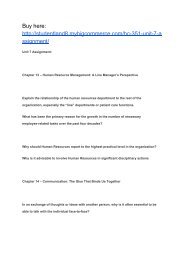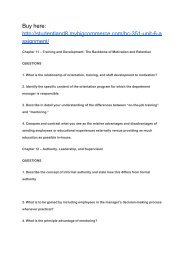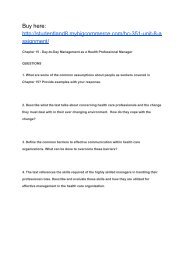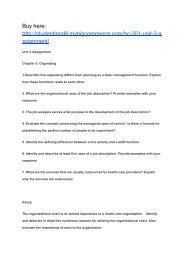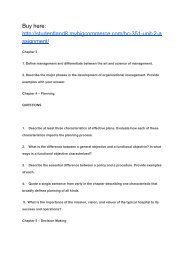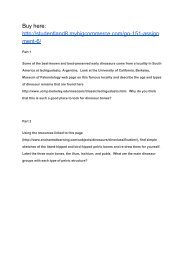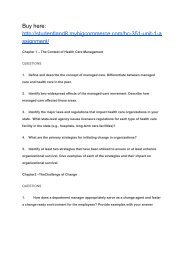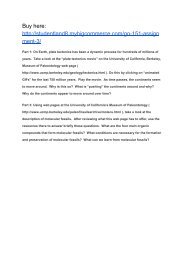Case 2: The Wallace Group (Corporate Governance: Executive Leadership)
Case 2: The Wallace Group (Corporate Governance: Executive Leadership)
Case 2: The Wallace Group (Corporate Governance: Executive Leadership)
Create successful ePaper yourself
Turn your PDF publications into a flip-book with our unique Google optimized e-Paper software.
Buy here:<br />
http://studentland8.mybigcommerce.com/case-2-the-wall<br />
ace-group-corporate-governance-executive-leadership/<br />
<strong>Case</strong> 2: <strong>The</strong> <strong>Wallace</strong> <strong>Group</strong> (<strong>Corporate</strong> <strong>Governance</strong>: <strong>Executive</strong> <strong>Leadership</strong>) Conduct a strategic<br />
analysis using the <strong>Executive</strong> Summary template. Prepare and submit a two page executive<br />
summary that discusses what strategic alternatives are available and provide a recommended<br />
strategy. You are to work alone to analyze and prepare the <strong>Executive</strong> Summary for the case.<br />
NOTE: Click "Submit Assignment" in the upper right hand corner of your screen to<br />
turn in your <strong>Executive</strong> Summary no later than Sunday, midnight CT. Name your file with your<br />
name and the unit number, i.e. Jones1 or Brown1. Your file should be in either Microsoft word<br />
(.doc or .docx) or rich text (.rtf) format.<br />
<strong>The</strong> following information will be required for the <strong>Executive</strong> Summary: TEXTBOOK CASE<br />
ANALYSIS<br />
GUIDANCE(CAG)<br />
and the TEXTBOOK BUSINESS CASE ANALYSIS EXECUTIVE SUMMARY<br />
TEMPLATE <strong>The</strong>se files are required for the unit textbook case studies.<br />
Synopsis of the <strong>Case</strong>: <strong>The</strong> content of the synopsis should present relevant background facts<br />
about<br />
the case under examination.<br />
Relevant Factual Information about the Problem or Decision the Organization Faced: State the<br />
precise problem or decision the organization faced. <strong>The</strong> section should include information that<br />
addressed the business issue under examination. This section should be no longer than a single<br />
paragraph.<br />
Explanation of Relevant Concepts, <strong>The</strong>ories and Applications Derived from Course Materials:<br />
This section should be the bulk of your paper. Analysis of the business problem or decision in<br />
light of the course concepts must be presented, as well as the business lesson another<br />
organization could learn from this situation. Besides citation to the text, learners must conduct<br />
research in the University library related to the top. Citing the textbook only is not enough to<br />
demonstrate you understand and can apply the course objectives. Here is where comparative<br />
and contrasting positions should be considered and examples and illustrations provided.<br />
Recommendations: Provide logical recommendations to address the business lesson identified<br />
above. <strong>The</strong> recommendations need not to be specific to the organization examined, but should<br />
consider how other organizations, if similarly situated, could lessen the impact of the problem or<br />
decision identified. Recall, that the organization under examination has already moved pasted<br />
this problem so any recommendations made, at this point, are fruitless. <strong>The</strong> focus of this section<br />
should be on what other companies should be aware of to address similar problems or decisions.<br />
Citation to<br />
the textbook alone is insufficient for analysis in this section. Learners should conduct research in<br />
the University’s library to support their positions. Depth of scholarship is not demonstrated by<br />
providing personal opinions alone, but by using examples, analogies, comparison and<br />
illustrations from the academic literature. Not only does this synthesize the material to assist the<br />
reader’s understanding, it is an effective way to present the academic sources and extend the<br />
discussion of your ideas. This section should be a paragraph or two.<br />
Alternative Recommendations: This section is not a continuation of the prior. Provide<br />
suggestions for how to avoid the problem or decision the examined organization faced. Analysis
here should be may be forward thinking, predictive or, most likely, preventative in nature but tied<br />
to the thesis statement. Again, opinion is insufficient to provide the required academic analysis.<br />
Sources, other than the text, must be provided to sustain the statements made. This section<br />
should be a paragraph,<br />
at most.<br />
Conclusion: End the assignment with a summary of the important points made in the document.<br />
No<br />
new information may be presented. Writing a conclusion can be done by rewording the opening<br />
or reformulation the topic sentences of each paragraph to make a summary for the reader. This<br />
section<br />
should be a paragraph, at most


